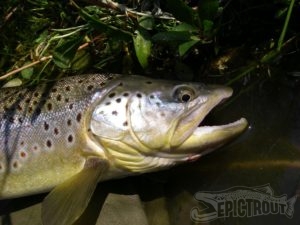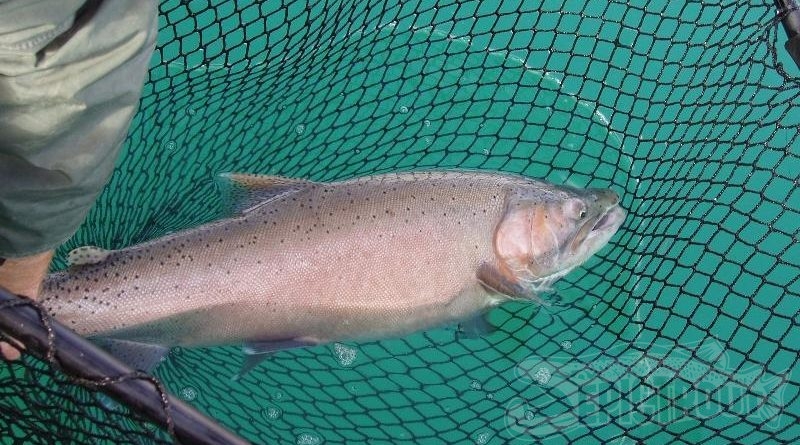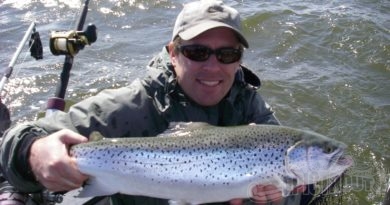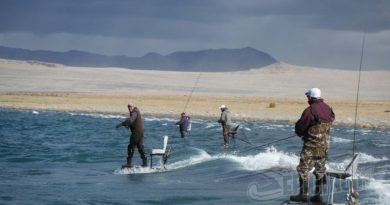*This is an updated version of an article I wrote for another site some years ago.
I come from a fish biology background so proper catch and release practices are important to me. During my time with the Oregon Department of Fish and Wildlife I worked at a fish ladder on the North Santiam river. My job was to enumerate and ID salmonids that passed through the main fish ladder near Stayton, Oregon. This required me to capture and handle all spring chinook and summer steelhead that passed through the ladder. During the several years that I worked this ladder, I handled many thousands of large salmon and steelhead. This experience with “catch and release” gave me an appreciation for the proper handling of large salmonids.
I also went through a 7 year “fly fishing only” phase. Much to the chagrin of my two “gut slinging” brothers, I adopted the stereotypical elitist attitude of many fly fisherman. After a while I realized that many of the largest trout to be caught like to eat other fish and the fly rod wasn’t necessarily the best way to catch these giants. But there were some important lessons learned during this time in relation to the handling of trout. One of the positive things gleaned was an appreciation for how to hold and handle a trout during the photograph and release session. These lessons would cross over into my new “trophy trout” phase.
I am going to break everything down step by step from hooking to release in this article. These are my opinions based upon my experiences. This article is geared specifically for the trophy trout angler. Trout are more sensitive than we think. Just because a fish swims off doesn’t mean that it is going to make it.
Ok, it all starts out with the hookup and fight of the fish. As the fish struggles, lactic acid builds up in the muscular regions of the fish. I am not going to go into all of the physiological factors that come into play, but basically, there are three main factors that we need to be aware of. Time of struggle, water temperature and size of fish. Basically the longer you play the fish the worse it is for the fish. The warmer the water the worse it is for the fish. The larger the fish the more the lactic acid build up plays a factor in its survival.
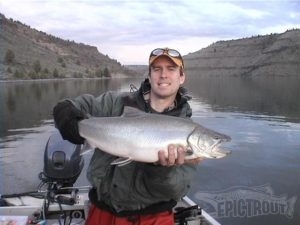
You can see why we, as trophy trout anglers need be extra concerned. We are targeting larger trout and more often then not we are playing them on a light drag for fear of pulling a hook or breaking a fish off. Summertime fish can be especially susceptible to stress induces by catch and release due to warm water temperatures above the thermocline. We need to try to get these fish landed as quick as feasible to give it the best chance of survival. Once a fish reaches “acidosis”, or a point where the lactic acid buildup is non reversible, it is only a matter of time before they die. Many anglers release fish thinking that they will survive when, in fact, the fish will die a few days later due to issues created during the fight and release.
After we get the fish to the net there are other concerns. When netting a trout you want to try to use a net with either rubber or coated nylon mesh. Rubber meshed nets are heavy and are hard to move quickly through the water so I recommend a coated mesh for trophy trout angling. Standard thin mesh nets wreak havoc on the trout’s protective slime coat and can split the caudal (tail) fin. Try to use a net with a large enough bag to allow the trout to rest in the water while you are working on getting the hooks out. Don’t be caught with a smallish net in case you do hook that fish of a lifetime.. be prepared with the right sized net!
Once the fish is in the net and the yells and high fives subside, the next step is to get the hooks out of the fish. I like to free the fish before I worry about getting the hooks out of the net mesh. I like to use long needle-nosed pliers to work the hooks out. Gently, but firmly work each hook out, trying to do as little damage to the fish as possible. Once the hooks are completely free of the fish and he is resting comfortably in the bag of the net, you can focus on freeing the lure from the net mesh. If it is a big fish I will usually just cut my line and move my rod out of the way so I can focus on the task at hand without the added hassle of an attached rod/reel. This also forces me to re-tie after any big fish just in case there are any weak spots in my line. Try to keep the fish fully submerged as you work on the hooks.
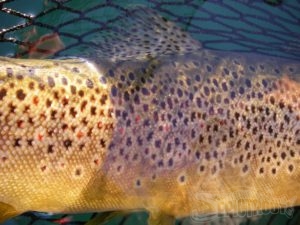
Fly fisherman obsess about barbless hooks. I did my own study when I was in college and found that the barbs were not that big of a deal when it comes to survival… but it did play a large role in how many fish were lost during a battle. Hook size was a much larger factor in fish mortality. Treble hooks tend to do more damage to the fish versus single hooks but most of us will be using trebles to give us the best chance at hooking that monster trout. The main thing to focus on is taking proper care when we remove the hooks, especially from smaller fish. These smaller fish are the trophies of the future.
So let’s talk about the many small trout that we release. I am amazed at how many guys will grab a little trout right around the belly and squeeze it with one hand while they work the hooks out and release the fish. Not only can this damage the protective slime coating, it can also crush internal organs like the air bladder. In my opinion it is better to never touch the fish at all… just twist and maneuver the hooks once the fish is near the boat. I like to control the fishing line with one hand and grab the shank of the hook with a pair of pliers with my other hand. I can usually twist the hook out by turning over the pliers and the fish falls right off. You should be able to “pop off” 95% of your small trout with hardly any damage to the fish and you never having to touch him.
I personally do not like boga grips or their derivatives for trout. They were designed for largemouth bass and other species with a totally different mouth structure. I cringe every time I see a large trout hanging from grippers, its backbone stretched to the breaking point at the nuchal (nape) of the trout’s neck. If you look carefully, you might even see a dark spot at the nuchal region the neck where internal contusion is occurring. Many of these fish will die in the next day or so, unbeknownst to the angler who “released” the fish.
Some of the grippers have “jaws” designed to hold the fish. These jaws are great at crushing and destroying trout’s mouth bones. If a fish thrashes while in the clutches of this style of gripper, you can do some terrible damage to the fish. Many anglers like grippers because you don’t have to touch the water or fish and can control the fish easily. The only situation that I would recommend a gripper is if the trout if under 4 pounds and you only used a boga grip style device to control the fish for ease of handling.
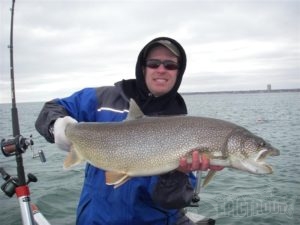
Ok, we now have the hooks out of our big trout and it is resting comfortably in the large bag of the net. We cut our line just above the lure and have been able to untangle the hooks from the mesh of the net and set our lure aside. Now it is time to weigh our fish. I like digital scales. They are easy to read and there is no mistaking what the scale says. The better ones are accurate enough for most situations and if you ever had a fish that you needed an exact weight then you could always pull out a more precise scale.
I like to weigh big trout in the net. If you weigh a large trout directly from the hook on your scale then you are probably going to do some unnecessary damage to the fish. Some digital scales have a tare preset that will allow you have have the weight of your net already tared. If your scale doesn’t have a tare preset then you can just weigh your wetted net and memorize that number to subtract from the combined weight.
So, hook the scale to the mesh of your net near the handle and lift the fish out of the water until you have a steady weight. In a perfect world you would never have the fish out of the water for more than 20 seconds at a time. After you get a solid weight that you are comfortable with you can get a length and girth if you so desire. Measure both length and girth with the fish in the net bag. Use a wetted soft measuring tape if possible. If you need a more accurate length measurement then you will need to measure on a wetted, flat, fish-friendly surface that has a measuring device integrated into it. When I worked for Fish and Wildlife we had a board with a ruler integrated into it that had a “hood” that covered the fish’s head to calm them down during measuring. After you get your measurements you can get get prepped for “camera time”.
Many trophy trout anglers like to keep their fish in a live well so they can show their buddies, get pictures or measure their fish at a later time. There are pros and cons to this method. The main benefit is that it revives the fish due to the fresh, oxygenated water and the cool shade that the live well usually provides. Thus, when the fish is ready to be released it will be in top notch shape. Some cons are that occasionally there are sharp edges in the live well that can damage a fish and more importantly the fish will be extremely energetic after being in the live well so it makes it harder to photograph and get your measurements/weights. Keep in mind that it may be illegal in some states to keep trout alive in your live well so check your regulations carefully.
I usually wear a thin cotton glove when I handle a large fish. While working in the fish trap on the North Santiam River I learned the importance of controlling a fish. Without a cotton glove, there will be that time when a large fish thrashes out of your grasp and drops into the water or onto the floor of your boat, neither good situations. A large trout flopping on the deck of your boat is about as bad a situation as you can have if you intend to release that fish.
Always wet your glove or hand before you handle the fish. This helps protect the fish from damage to its slime coating. My preferred method of photographing a large trout is to have one hand controlling the fish at the wrist of the tail and the other supporting the fish near its mid-section. Never hold a fish by or near the gills. Trout are used to having their body weight supported by the neutral weight of their water environment. A vertical hold on a large trout will put pressure on all of the internal organs and can do permanent damage that the angler may never suspect. For extremely large lake trout I recommend that you “hug” the fish with both arms to fully support it.

Now we are ready for the photo sesh. Have your buddy or self timer ready to go with the camera and pull the fish out of the net for the photo. After you snap a pic of the fish, get it back into the net and water as quickly as possible. Repeat until you get the shot that you want. I recommend that you hold the fish at about half an arms length from your body and fill the frame with mostly you and the fish. But, we can cover that in another article!
By this time, your fish should be getting revived from its time in the bag of the net. Gently remove him and work him slowly back and forth in the water, keeping a gentle grasp on the caudal peduncle (wrist of the tail). Do not shove the fish back and forth… just move it gently… being more aggressive on the forward stroke that will drive water through the gills in the proper direction. Keep working the fish until he begins to try to kick free of your grasp. Slowly lighten the grip you have on the wrist of the tail until the fish powers out of your grasp. Hopefully the fish will power down and away. A fish swimming off on the surface is not a good sign and that is an indication that the fish was not ready for release or has suffered some trauma.
Lake trout present their own special dilemma since many are caught from great depths and can suffer from distended air bladders, (barotraumas) when caught with rod and reel. Lake Trout do have a small air duct that is attached to their air bladder, (known as physostomi) which allows them to “burp” air to help adjust to pressure. Typically if you retrieve a lake trout slow enough they may be able to burp much of the air bladder gasses by the time they reach the surface. For those fish that are suffering barotrauma it is recommended that you use some sort of device to lower the fish back to the depth that you caught it. Years ago it was recommended that you “fizz” these fish with a needle to remove the excess air but that method is no longer recommended by most biologists due to infections that can occur at the insertion point.
I have seen a variety of methods work on trout suffering from barotrauma. I have seen upside down milk crates with weights lowered with the fish inside it. I have seen guys attach the fish to their release clip on their downrigger and drop the fish down that way. I have seen gizmos attached to the downrigger ball to get them down to depth and released. Recently I have noticed some devices showing up on the internet that are advertised as release devices for baroutromed trout. These devices were originally designed for releasing rockfish but have been modified to work with lake trout with some pretty good success. Here are links to 2 of these devices:
http://www.sheltonproducts.com/SFD1.pdf and http://www.lakersaver.com Both of these devices work well and should be looked at by any serious trout angler who is dealing with barotraumas during their fishing exploits.
Another important note. If a fish is bleeding from any portion of its gills then the fish will certainly die. Don’t kid yourself! Studies have shown that any blood coming from the gill region equals certain death. If the fish is bleeding from it mouth area or another cartilaginous region then it will probably be fine. If you don’t think the fish will survive then it is best to keep it. There is no point in wasting the fish.
I prefer to release 99.9% of the trout I catch. I have fished with others who keep anything over 5 pounds. Though I support CPR (catch, photograph, release), the decision to keep or release a fish is up to the individual. Some people get off on flaming anyone with a dead trophy trout. Maybe we can focus on educating rather than flaming. I can tell you that a properly handled trophy trout swimming to its freedom can leave you with a great feeling of satisfaction.
I try to release every trout as carefully as possible and I hope you will too. It is nice to think that a 14″ fish that you released 7 years ago could be someone else’s fish of a lifetime today!
Mark Knoch




